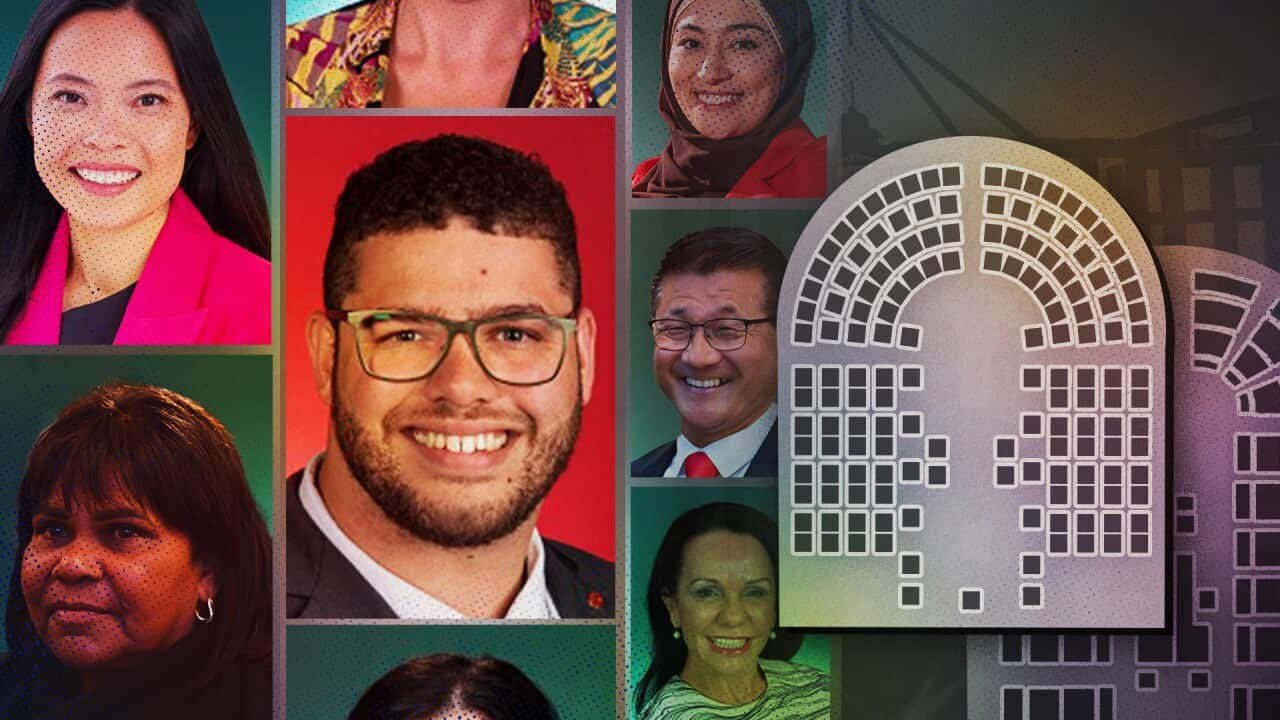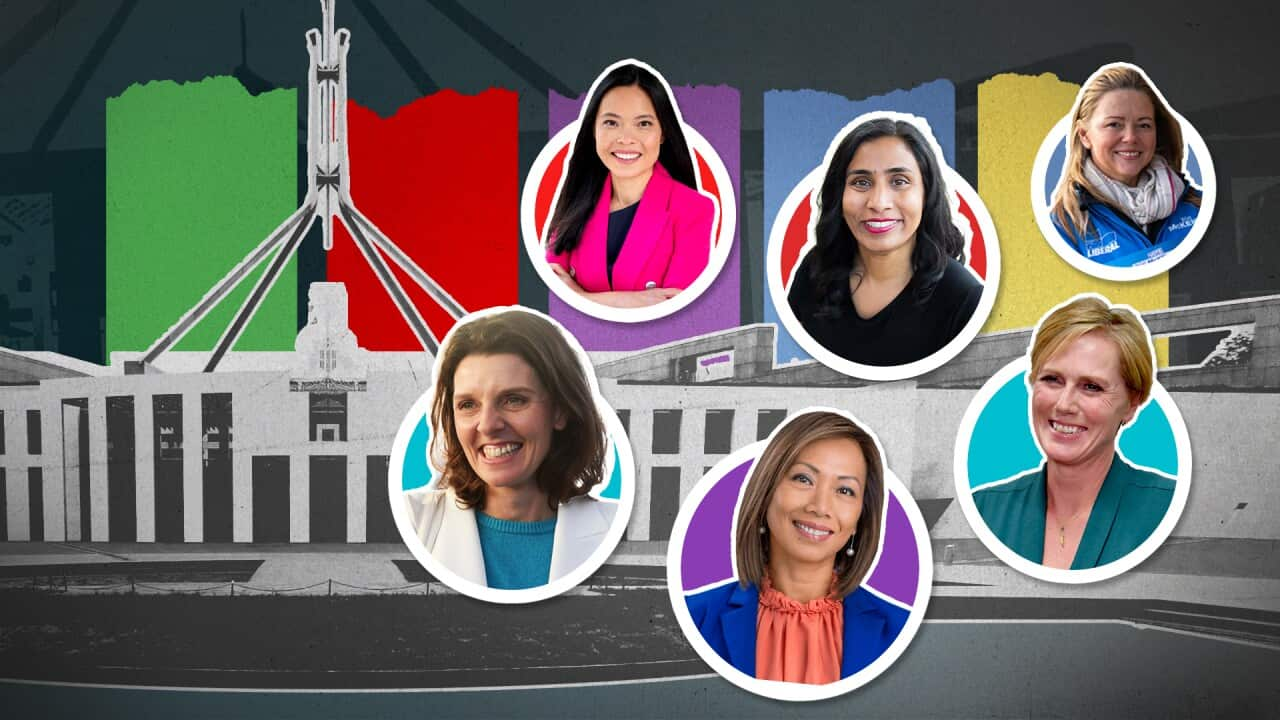Australia's 47th parliament has been officially declared by the Australian Electoral Commission (AEC), and it's been hailed as one of the most diverse in the country's history.
With the 151 members in the House of Representatives and the 40 positions that were up for election in the Senate now confirmed, there has been an uptick of women in the House of Representatives, the number of Asian-Australian politicians has doubled and Indigenous representation is now reflective of the national population.
But of all of the 227 parliamentarians, there is only one person who presents a visible disability: WA Greens Senator Jordon Steele-John.
According to 2020 data from the Australian Institute of Health and Welfare, nearly one in three Australians live with a disability. About 40 per cent of Australians live with either a disability or a chronic health condition.
Senator Steele-John told SBS News that while the diversity in Australia's new parliament is "absolutely something to celebrate", there remains a critical issue that he "remains the solely visible disabled person in parliament".
"That betrays a really serious issue. It shows we have a lot more work to do to ensure our social and political structures include people from a range of backgrounds," he said.
Senator Steele-John — who has been elected to the Senate in 2017 — said the current make-up of the Australian parliament sends a message to those from marginalised communities that "parliament is not a place for them".

WA Senator Jordon Steele-John is the Greens' spokesperson for Disability Rights and Services. Source: AAP / Lukas Coch
"Being visible as a disabled person — whether your disability is visible or not — makes it safer for others to be visible.
"It helps make ableism less socially acceptable, it makes disability an identity to be proud of, and it challenges people’s flawed expectations of disabled people."
He stressed the need to include more people with disability at a grassroots level to be heard adequately. Then, affirmative action must be taken as a "critical" measure to improve representation, he said.
People With Disability Australia President Samantha Connor said levels of disabled representation were "astounding".
She added: "Our parliament should be a true ‘parliament of the people’ and reflect the community - there should be Aboriginal people, people of colour, disabled people, older Australians and younger people, as well as people from low socioeconomic backgrounds."
Executive director of think tank Per Capita Emma Dawson agreed that while the outcome of the 47th parliament was "much improved", there was "still work to do".
Women's ranks rise
Twenty more women were elected to the House of Representatives this election, now making up 38.4 per cent of members in the lower house.
It's a marked increase from the last parliament of 31.9 per cent, as of December 2020, according to Parliamentary Library figures, making this parliament the most gender-diverse in history.
Of the 20 new women who have been elected, 10 are Labor MPs, two are Liberal MPs, one is a Greens MP and seven are independents. They join the existing 38 women who have retained their seats.
The new parliament also now has 43 women in the Senate, making up 56.5 per cent of the upper house. That's up from 52.5 per cent in the previous parliament.
"Women aren't the minority. We're half the population — slightly more than half the population — and having equal representation there is absolutely fundamental," Ms Dawson said.
Indigenous representation climbs
For the first time in Australian history, there are 10 Aboriginal and Torres Strait Islander politicians in parliament.
That's a 67 per cent rise compared to the last parliament, where only six members of parliament were Indigenous.
It also marks the first time Aboriginal and Torres Strait Islander representation in parliament is proportionate to their population, of where they make up 3 per cent.
Notably, Wiradjuri woman, to be sworn into parliament, taking up the role of Minister for Indigenous Australians.
She took over the role from Noongar, Yamatji and Wongi man, Liberal MP Ken Wyatt, who lost his Perth seat of Hasluck to Labor's Tania Lawrence.
Other additions include Marion Scrymgour and Gordon Reid in the lower house, as well as Jacinta Price and Jana Stewart in the Senate.
It also means for the first time two Indigenous women will be heading the NT Senate seats, with Senator Price joining Labor's Malarndirri McCarthy.
Asian-Australian representation more than doubles
Only three Australians from Asian backgrounds were in the House of Representatives prior to the 2022 federal election. Those figures have has since more than doubled in what has been described as a "huge improvement" by Ms Dawson.
Among the newest faces is Labor's who speaks nine languages other than English. His surprise victory came in what was once a Liberal safe seat in the WA electorate of Tangney.
Others include Dai Le in Sydney’s Fowler, Michelle Ananda-Rajah in Melbourne’s Higgins, Zaneta Mascarenhas in Perth’s Swan, Sally Sitou in Sydney’s Reid and Cassandra Fernando in Melbourne’s Holt.
But advocates remain dissatisfied with the 4 per cent of Asian-Australian representation in parliament. This is compared to 16 per cent of Australia’s population being born in Asian countries, according to the 2016 Census.
Despite this, Ms Dawson says she is confident Australians will see — and vote for — more politicians with Asian backgrounds with time.
"Australia's history of multiculturalism and immigration moves very slowly," Ms Dawson said.
"It takes time when those communities are established for them to infiltrate, if you like, to break down those barriers."
And with Labor's Sally Sitou taking the reins in the multicultural seat of Reid, and independent MP Dai Le taking the safe seat of Fowler from Kristina Keneally, Ms Dawson says one message is clear.
"It's really important ... that those communities are represented by people that reflect the reality of that community," Ms Dawson said.
"I think the challenge now is to ensure that they hold on to those seats next time around."
First Muslims make it into federal parliament
It was a moment of firsts for Muslim representation in the 47th parliament, with the .
Senator Payman is also the first Afghan refugee who has been voted into parliament, a background that Ms Dawson believes is critical to being represented in Australian politics.
"Having parliamentarians with refugee backgrounds I think is really important to understanding our nation," Ms Dawson said.
"Other than the First Nations people, we all come from some form of immigrant background.
"It's really important that the people that represent us in our parliament actually reflect the ethnic and cultural make-up of the country."













